Mindful walking is a powerful technique to ease anxiety by combining physical activity with present-moment awareness. You'll focus on your breath, body movements, and surroundings as you walk, grounding yourself in the here and now. This practice can reduce stress, improve mental clarity, and enhance overall well-being. Start with short 10-15 minute walks, wearing comfortable shoes and choosing a safe route. Pay attention to your senses, incorporate gratitude, and use positive affirmations to amplify the benefits. By creating a regular routine and combining it with other anxiety-management techniques, you'll develop a robust toolkit for managing stress. Discover how each intentional step can lead you towards greater calm and peace of mind.
Key Takeaways
- Mindful walking combines physical activity with mindfulness meditation to reduce anxiety and stress.
- Focus on breath, body movements, and surroundings while walking to stay grounded in the present moment.
- Engage all senses during walks to enhance mindfulness and reduce anxious thoughts.
- Incorporate gratitude practice and positive affirmations into your walking routine for added mental benefits.
- Create a consistent mindful walking routine, gradually increasing duration and combining with other anxiety-reduction techniques.
Understanding Mindful Walking

Mindful walking is a simple yet powerful practice that combines the benefits of physical activity with mindfulness meditation. It's a form of moving meditation that encourages you to focus on the present moment while you walk. Unlike regular walking, where your mind might wander or fixate on worries, mindful walking keeps you engaged with your surroundings and bodily sensations.
When you practice mindful walking, you'll pay attention to each step, feeling the ground beneath your feet and noticing the rhythm of your movement. You'll observe your breath, the sensations in your body, and the environment around you without judgment. This technique helps you cultivate awareness and presence, reducing anxiety by grounding you in the here and now.
You don't need any special equipment or location to practice mindful walking. You can do it anywhere, from a busy city street to a quiet nature trail. The key is to approach your walk with intention and curiosity, allowing yourself to fully experience each moment as it unfolds.
Benefits for Anxiety Management
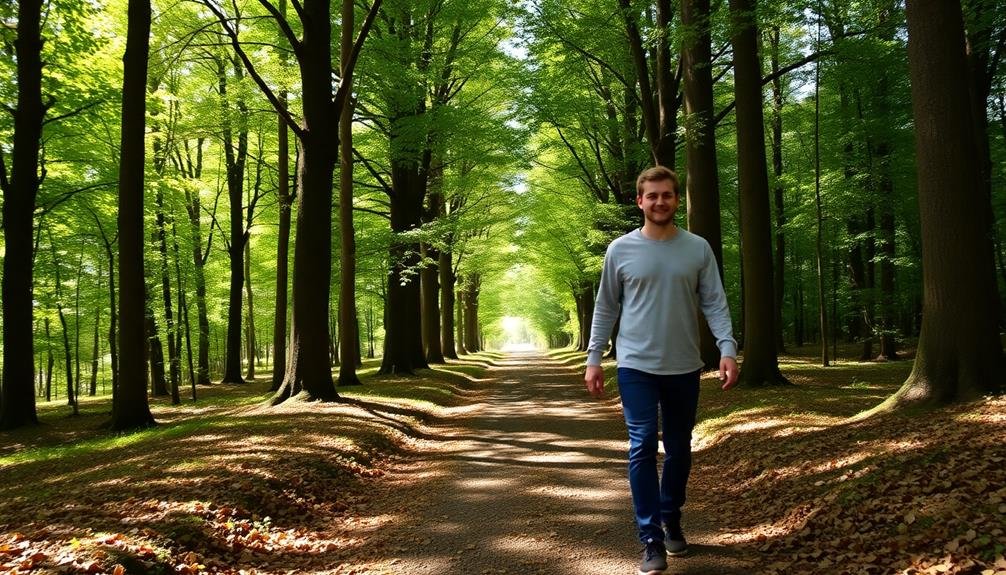
When it comes to managing anxiety, mindful walking stands out as a powerful tool. By combining physical activity with mindfulness techniques, you'll experience a range of benefits that can greatly reduce your anxiety levels.
As you practice mindful walking, you'll notice improvements in both your mental and physical well-being. The rhythmic nature of walking helps regulate your breathing and heart rate, promoting a sense of calm. Meanwhile, focusing on your surroundings and bodily sensations anchors you in the present moment, reducing worry about the future or rumination about the past.
| Mental Benefits | Physical Benefits |
|---|---|
| Reduced stress | Improved posture |
| Clearer thinking | Better circulation |
| Enhanced mood | Increased energy |
| Greater focus | Better sleep |
Preparing for Your Walk
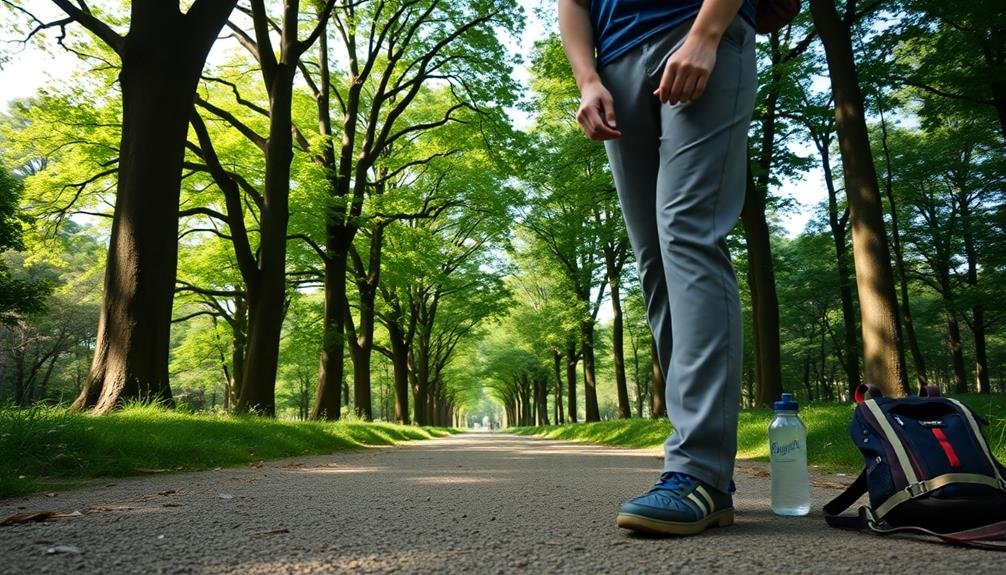
Before you head out for your mindful walk, make sure you've got comfortable walking shoes to support your journey.
Set a realistic time goal for your walk, whether it's 10 minutes or an hour.
Plan your route in advance, choosing a path that feels safe and conducive to your practice of mindfulness.
Choose Comfortable Walking Shoes
Comfortable shoes are essential for a successful mindful walking experience. When choosing footwear for your mindful walk, prioritize support and cushioning over style. Look for shoes with a flexible sole that allows your feet to move naturally, promoting better posture and reducing strain on your joints.
Opt for breathable materials like mesh or leather to keep your feet cool and dry during your walk. Make sure there's enough room in the toe box to wiggle your toes comfortably, as this helps maintain balance and prevents blisters.
Consider shoes with good arch support to minimize fatigue and discomfort, especially if you have flat feet or high arches. If you're walking on uneven terrain, choose shoes with good traction to prevent slips and falls.
For longer walks, invest in moisture-wicking socks to keep your feet dry and blister-free. Remember to replace your walking shoes regularly, typically every 300-500 miles, as worn-out shoes can lead to discomfort and potential injuries.
Set Walking Time Goal
Now that you've got the right shoes, it's time to plan your mindful walking routine. Setting a realistic time goal for your walks is essential to establishing a consistent practice. Start small, aiming for just 10 to 15 minutes per day if you're new to mindful walking. This duration is long enough to experience benefits but short enough to fit into a busy schedule.
As you become more comfortable with the practice, gradually increase your walking time. Aim for 20 to 30 minutes per session, which research suggests can considerably reduce anxiety symptoms.
Remember, consistency is more important than duration, so it's better to walk for shorter periods daily than to have long, infrequent sessions.
Consider your daily schedule when setting your time goal. You might prefer a morning walk to start your day with a calm mindset or an evening stroll to unwind after work.
If finding a continuous block of time is challenging, try breaking your walk into shorter segments throughout the day. For example, two 15-minute walks can be just as effective as one 30-minute session.
Plan Your Walking Route
A well-chosen route can enhance your mindful walking experience. Consider the environment that'll best support your anxiety-reducing goals. Opt for paths with natural elements, like parks or tree-lined streets, as these can promote relaxation. If you're sensitive to noise, seek quieter areas away from traffic. Alternatively, if you find comfort in bustling environments, a busy neighborhood might suit you better.
Plan your route in advance to avoid stress during your walk. Factor in safety, especially if you'll be walking early morning or evening. Choose well-lit areas and paths you're familiar with. Consider the terrain as well; a flat route might be best for beginners, while those seeking a challenge could incorporate hills.
| Route Type | Benefits | Considerations |
|---|---|---|
| Nature Trail | Calming, scenic | Weather-dependent |
| Urban Park | Convenient, structured | Potentially crowded |
| Neighborhood Streets | Familiar, customizable | Traffic, less nature |
Focusing on Breath and Movement
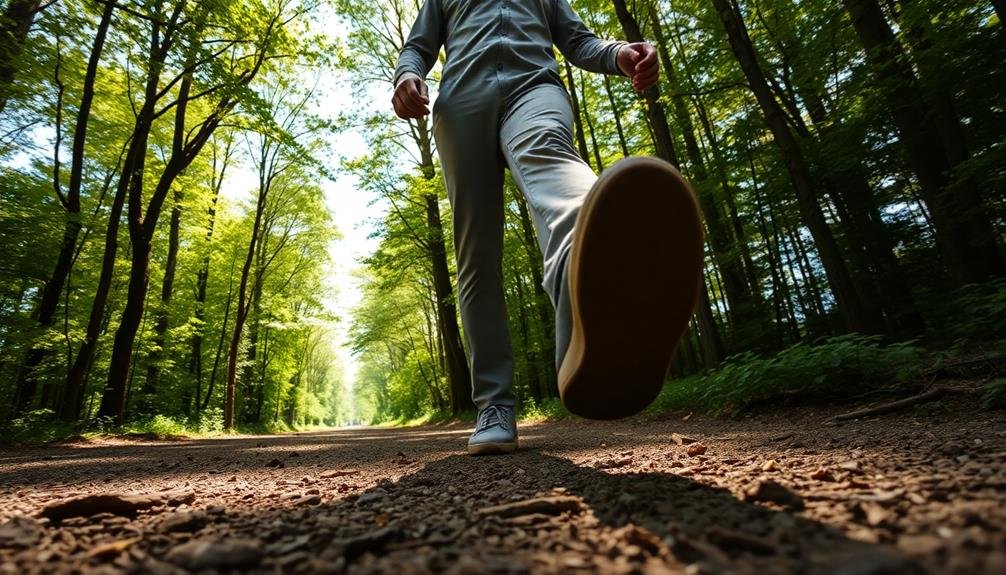
While practicing mindful walking, focusing on your breath and movement creates a powerful synergy that enhances the experience. As you begin your walk, pay attention to your breathing pattern. Take slow, deep breaths, inhaling through your nose and exhaling through your mouth. Synchronize your breath with your steps, perhaps inhaling for three steps and exhaling for four.
Notice how your body moves as you walk. Feel the shifting of your weight from one foot to the other, the roll of your heel to your toes, and the swing of your arms. Be aware of the muscles engaged in each step, from your calves to your core. As you focus on these physical sensations, you'll naturally draw your attention away from anxious thoughts.
If your mind wanders, gently bring it back to your breath and movement. Don't judge yourself for getting distracted; it's a normal part of the process. Instead, simply refocus on the present moment, the rhythm of your steps, and the flow of your breath.
This mindful connection between breath and movement can help calm your nervous system and reduce anxiety.
Engaging Your Senses

Engaging your senses during mindful walking can deepen your connection to the present moment and further alleviate anxiety. As you walk, focus on each sense individually, allowing yourself to fully experience your surroundings.
Start with sight. Notice the colors, shapes, and textures around you. Observe how light plays on different surfaces and the movement of objects in your environment.
Next, tune into your sense of hearing. Listen for both loud and subtle sounds, from birds chirping to the rustle of leaves or distant traffic.
Pay attention to touch. Feel the ground beneath your feet, the air on your skin, and the movement of your clothes as you walk. Notice temperature changes and variations in texture.
Then, focus on smell. Inhale deeply and identify any scents in the air, from flowers to earthy odors.
Lastly, if appropriate, engage your sense of taste. Notice any lingering flavors in your mouth or take a sip of water to refresh your palate.
Practicing Gratitude While Walking

Incorporating gratitude into your mindful walking practice can greatly enhance its anxiety-reducing benefits. As you walk, consciously focus on things you're thankful for in your immediate environment and life. Start small by appreciating the ability to walk, the fresh air you're breathing, or the sunlight warming your skin.
Next, expand your gratitude to encompass larger aspects of your life. Reflect on supportive relationships, personal achievements, or opportunities you've been given. With each step, mentally list one thing you're grateful for, allowing positive emotions to fill your mind and body.
You can also use visual cues in your surroundings to prompt gratitude. When you see a tree, express thanks for nature's beauty. Passing a school might remind you to appreciate your education.
Encountering others on your walk can spark gratitude for community and human connection.
Overcoming Challenges During Walks
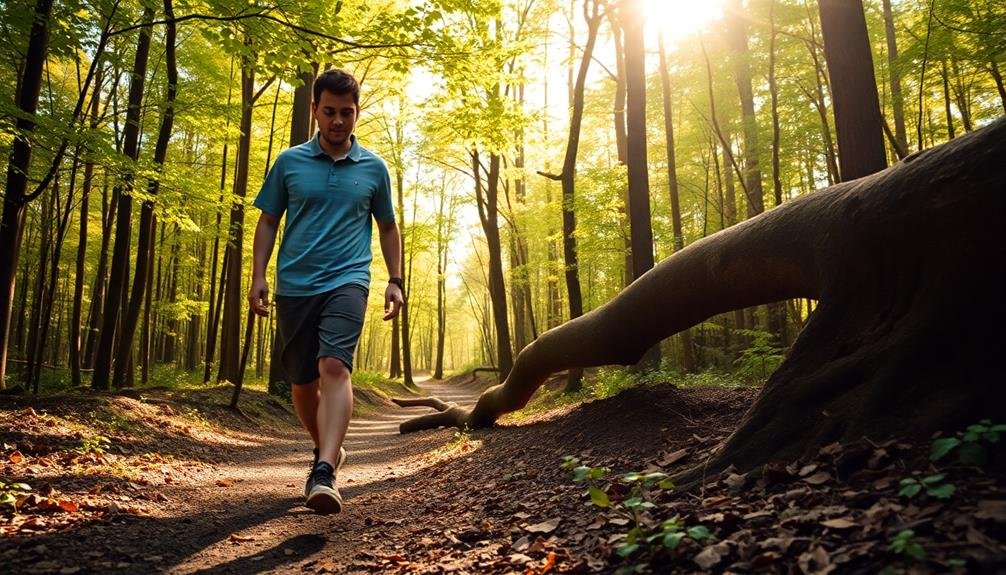
Mindful walking can present several challenges that may disrupt your practice. Common obstacles include external distractions, internal resistance, and physical discomfort.
To overcome these, try focusing on your breath or footsteps when noise or visual stimuli become overwhelming. If your mind wanders, gently redirect your attention to the present moment without judgment.
When you're feeling unmotivated or resistant to walking, remind yourself of the benefits and start with a short, manageable distance. You can gradually increase the duration as you build confidence and consistency.
For physical discomfort, adjust your pace or choose a more comfortable route. If you have existing injuries or health concerns, consult a healthcare professional for advice on safe walking practices.
Weather conditions can also pose challenges. Dress appropriately for rain, cold, or heat, and have indoor alternatives ready when necessary.
If safety is a concern in your area, walk with a companion or choose well-lit, populated routes. Remember, the goal is to cultivate mindfulness, so be patient with yourself and adapt your practice as needed.
Incorporating Affirmations Into Steps

As you walk, sync your breath with your steps to create a rhythmic pattern.
You can enhance this practice by incorporating positive mantras or affirmations into your walking routine.
With each step, silently repeat an empowering phrase that resonates with you, such as "I am calm" or "I release my worries," allowing these words to anchor your mind and soothe your anxiety.
Syncing Breath With Steps
Walkers can enhance their mindful practice by syncing their breath with their steps and incorporating affirmations. This technique, often called "breath walking," allows you to focus on your breath and movement simultaneously, creating a deeper sense of mindfulness.
Start by establishing a comfortable walking pace. As you walk, breathe in for a set number of steps, then breathe out for the same number. For example, inhale for four steps, then exhale for four steps. Adjust this ratio to suit your natural breathing rhythm and walking speed.
As you sync your breath with your steps, you can also incorporate affirmations. Choose a positive phrase or word that resonates with you, such as "I am calm" or "peace." Mentally repeat this affirmation as you walk, coordinating it with your breath and steps. For instance, think "I am" as you inhale for four steps, then "calm" as you exhale for four steps.
This practice helps quiet your mind, reduce anxiety, and create a sense of inner peace. It's a powerful tool for grounding yourself in the present moment and cultivating a positive mindset during your walk.
Positive Mantras While Walking
Building on the concept of breath walking, incorporating positive mantras into your steps can further enhance your mindful walking experience. Choose a short, uplifting phrase that resonates with you, such as "I am calm" or "Peace surrounds me." As you walk, mentally repeat this mantra in sync with your footsteps. You might say one word per step or divide longer phrases across multiple steps.
This practice helps redirect your focus from anxious thoughts to positive affirmations. It's especially effective when you're feeling overwhelmed or stressed. Your mantra can be general or specific to your current situation. For example, if you're worried about an upcoming presentation, try "I am confident and prepared."
Experiment with different mantras to find what works best for you. Some people prefer to change their mantra daily, while others stick with one for an extended period.
You can also create a rhythm by emphasizing certain words or syllables as you step. This technique not only calms your mind but also reinforces positive self-talk, gradually reshaping your thought patterns and reducing anxiety over time.
Creating a Mindful Walking Routine
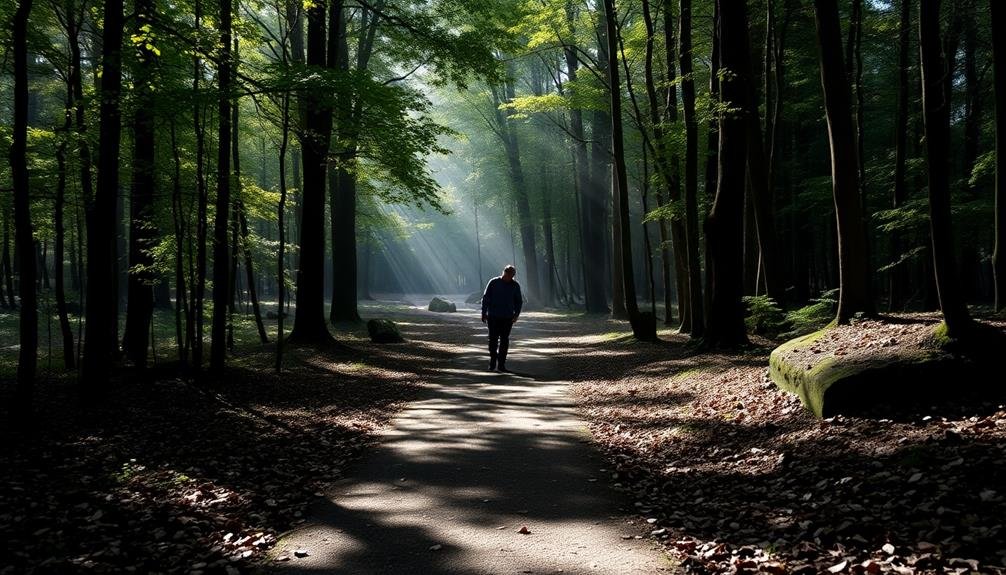
Consistency is key when establishing a mindful walking routine. You'll want to set aside dedicated time each day for your practice, even if it's just 10-15 minutes. Choose a time that works best for you, whether it's early morning, during lunch breaks, or in the evening after work.
Select a route that's conducive to mindfulness, preferably one with minimal distractions and some natural elements. As you develop your routine, consider incorporating these elements:
- Breath awareness
- Body scanning
- Sensory focus
- Gratitude practice
- Intention setting
Start each walk with a clear intention, focusing on your breath and the sensations in your body. As you walk, pay attention to the rhythm of your steps and the feeling of your feet connecting with the ground.
Notice the sights, sounds, and smells around you without judgment. Gradually increase the duration of your walks as you become more comfortable with the practice.
Combining With Other Anxiety Techniques
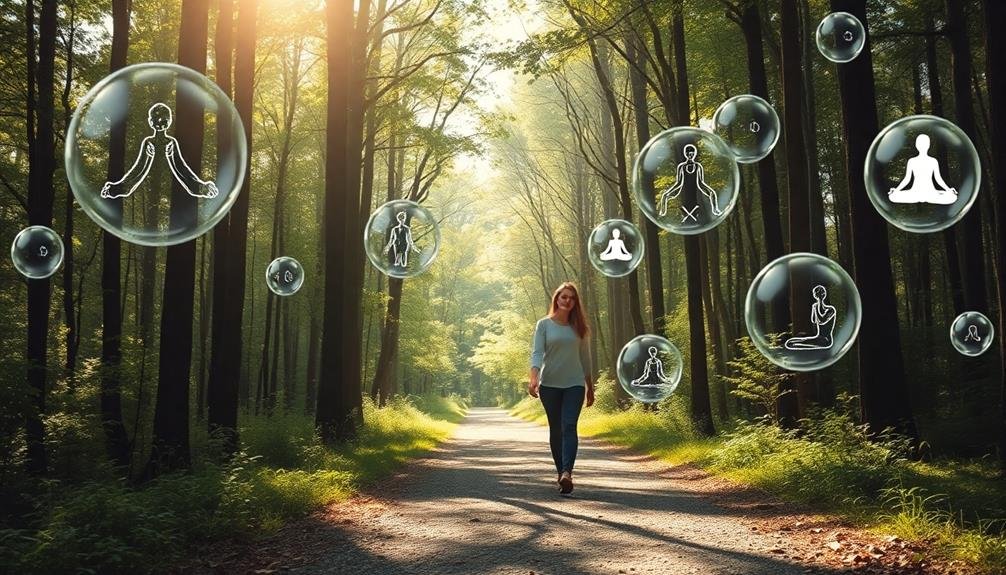
Mindful walking can be a powerful anxiety-management tool on its own, but it's even more effective when combined with other techniques. As you incorporate mindful walking into your routine, consider pairing it with deep breathing exercises. Before you start your walk, take a few moments to practice diaphragmatic breathing, focusing on slow, controlled inhalations and exhalations.
During your walk, you can integrate positive affirmations or mantras. Choose a short, empowering phrase to repeat silently as you step, syncing it with your breath. This combination of movement, breath, and positive self-talk can greatly reduce anxious thoughts.
You might also try progressive muscle relaxation while walking. As you move, consciously tense and relax different muscle groups, starting from your feet and working your way up to your head. This practice can help release physical tension associated with anxiety.
Consider incorporating mindfulness apps or guided audio sessions into your walks. These can provide structure and additional relaxation techniques as you move.
Frequently Asked Questions
Can Mindful Walking Be Effective for Children With Anxiety Disorders?
Yes, mindful walking can be effective for children with anxiety disorders. You'll find it helps them focus on the present moment, reduces stress, and improves their overall well-being. It's a simple, accessible technique they can easily learn and practice.
How Does Mindful Walking Compare to Traditional Meditation for Anxiety Relief?
You'll find mindful walking and traditional meditation both effective for anxiety relief. While meditation's stationary, walking adds physical movement. You're engaging your body and senses more actively, which can be particularly helpful for restless individuals.
Are There Specific Shoes or Clothing Recommended for Mindful Walking?
You don't need special gear for mindful walking. Wear comfortable shoes and loose-fitting clothes that allow easy movement. Focus on what feels good rather than specific brands. The key's your mindset, not your outfit.
Can Mindful Walking Be Practiced Indoors or in Small Spaces?
You can absolutely practice mindful walking indoors or in small spaces. It's not about distance, but awareness. You'll find that even pacing in a room or walking in place can be effective for mindfulness exercises.
How Long Should a Mindful Walking Session Last for Optimal Anxiety Reduction?
You'll find that the ideal duration for mindful walking varies. Aim for 10-30 minutes initially. As you practice, you can extend sessions. Listen to your body and adjust the time based on your comfort and anxiety levels.
In Summary
You've now learned how mindful walking can ease your anxiety. By incorporating intentional steps, breath focus, and sensory awareness into your routine, you're equipping yourself with a powerful tool for managing stress. Remember, it's okay to face challenges; persistence is key. As you continue to practice, you'll likely find that mindful walking becomes a natural part of your day, complementing other anxiety-management techniques. Take that first step today and embrace the calm that follows.
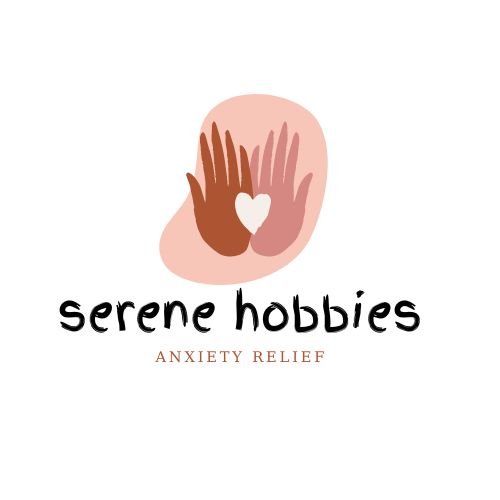

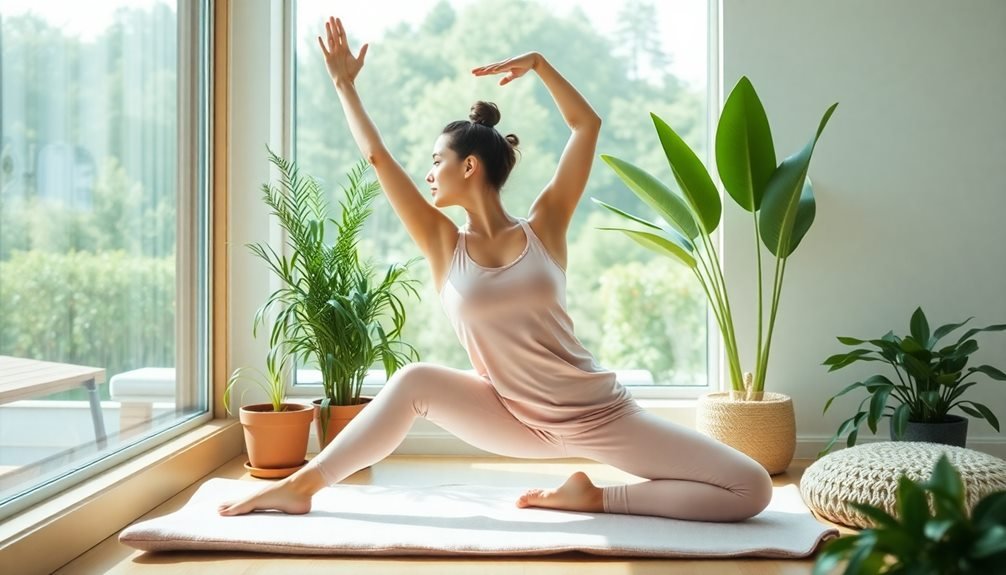
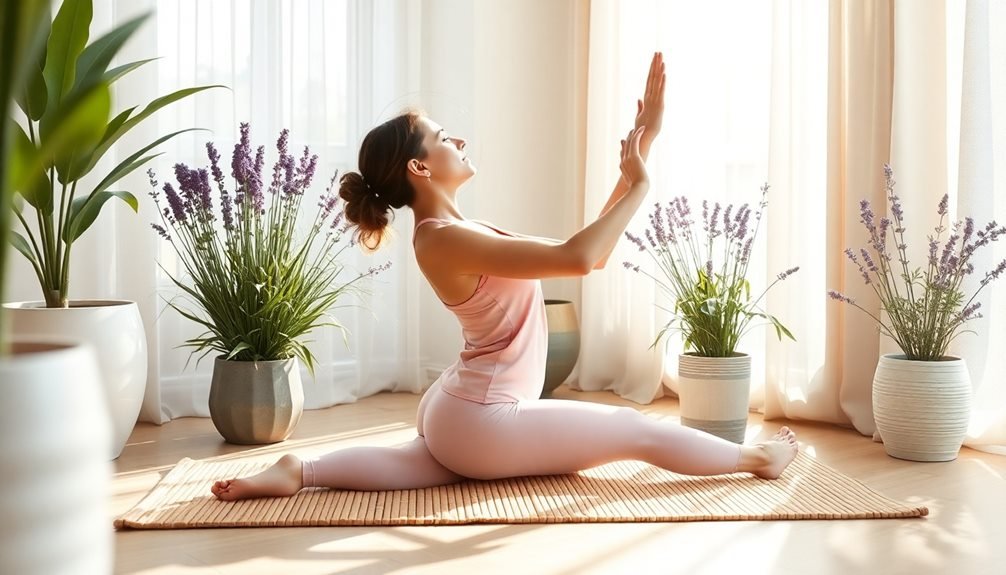
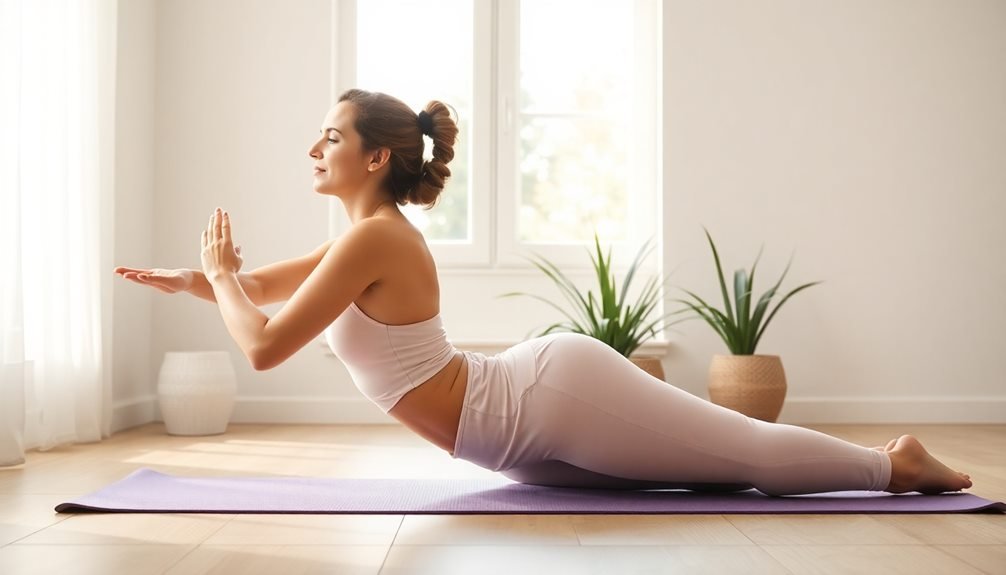
Leave a Reply